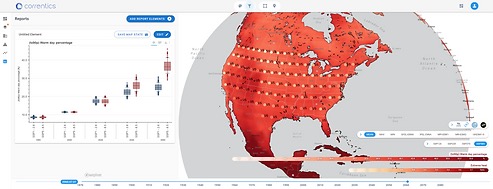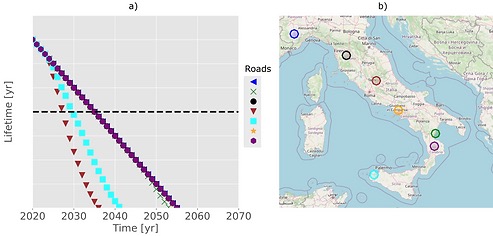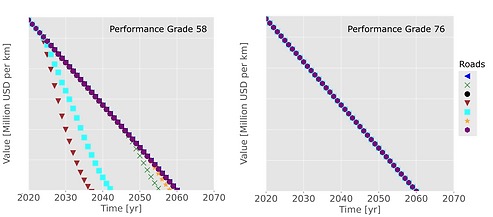Projects
Bumpy Roads Ahead: How Climate Change is Leading to Increased Infrastructure Failure
As the impacts of climate change become more apparent, a growing concern arises: How will our road infrastructure cope with the challenges presented by a changing climate? Recent scientific studies have drawn attention to the vulnerability of roadways, particularly in the face of rising temperatures and extreme weather events. ¹ ² ³ ⁴
In recent years, incidents of heat-related road damage have been observed, with notable examples including scorching summers in Europe during 2015 and 2018. ⁵ ⁶ Beyond immediate events, the long-term changes in average climate conditions also raise concerns regarding the durability of roadways. ³

Climate change-induced infrastructure failure
Drawing on data from climate models, researchers have identified a significant projected increase in road damage due to extreme precipitation and soaring temperatures, especially under high emission scenarios. ⁴ Overall, the consequences of anthropogenic climate change include the possibility of infrastructure failure occurring faster, which can result in higher maintenance costs. ¹ Constraining the rise in global warming to 2°C would result in annual operation and maintenance savings of 3.5bn euros for the Europe Union. ²
The primary objective of roadway design should be to ensure optimal functionality, safety, and durability. However, the materials utilized for construction are frequently chosen based on the assumption of a stable climate. In the US, following the current standard for material selection is estimated to add US $19bn to pavement costs by 2040 under the RCP4.5 warming scenario. ¹ Damage to road infrastructure may trigger more interruptions for maintenance, thereby blocking or delaying important transport routes, which has an impact on supply chains. This necessitates a comprehensive examination of how shifting climatic patterns might affect road networks, as well as the selection of suitable construction materials, design practices, and maintenance strategies. Currently, regional historical climate conditions are commonly used to select the materials for roadways. Climate model predictions can support engineers in the selection of materials that can withstand changes in climate in the next decades, leading to significant operational and maintenance cost savings for companies and a decrease in accidents related to the degradation of the pavement infrastructure.

Figure 2: Correntics’s climate-risk platform: Warm day percentage (climate index tx90p) prediction in 2060 in the US under the shared socio-economic pathways SSP5-8.5 (fossil-fuel development scenario). The evolution of the warm day percentage between 1980 (<10%) and 2060 (around 25% and 46% under SSP1-2.6 and SSP5-8.5, resp.) is shown on the left panel.
Climate-risk impact on road infrastructure in Italy
To assess the economic impact of climate change on road infrastructure, Correntics performed an analysis of the response of major roads in Italy to temperature changes using its climate-risk analytics tools. Based on the results of several road specific-studies¹ ² ³ on the economic implications of projected temperature changes on paved roads, we constructed customized vulnerability functions to assess climate impact estimates of road failure for seven major roads in Italy under different climate scenarios using the Correntics’ climate-risk framework. The vulnerability functions allow us to map the hazard (increase in extreme temperatures in the present case) in terms of risk (operating and maintenance costs).
Increasing costs and reduced lifetime of roads with future climate warming
We estimated the increase in operating and maintenance cost² for these major roads under different climate scenarios.
Our analysis shows that the mean annual damage under a warming climate on roads increases for all shared socioeconomic pathways (SSPs) (see Figure 3), which is a direct consequence of the increasing temperature and the negative effect on the materials’ stability. From the mid-century onward, the climate projections diverge, with the financial impact being up to 1.5 times greater for a scenario with reduced mitigation (SSP5-8.5) versus a pathway with substantial climate change mitigation and adaptation (SSP1-2.6). The annual damage evolution over the next decades is similar for the different Performance Grades considered, where a Performance Grade characterizes the grade of asphalt used for a road to operate within a given range of temperature. As expected, the lower the road’s Performance Grade is, the higher the damage.

Figure 3: Estimate for annual heat-induced impacts for highway infrastructure for a Performance Grade of 58 (left panel) and 52 (right panel). The general trend is an increase in the mean annual damage for all SSP pathways. Newly constructed streets are assumed for the calculation of the annual mean (non-cumulative) damage. A Performance Grade of 58 implies that if the pavement temperatures frequently exceed 58°C, the road will degrade at a faster rate than normal and will require a higher level of maintenance. A road with such a grade will be operating at pavement temperatures below 58°C in 98% of the time.
For the different roads analyzed, we also assessed the change in road lifetime under the SSP3-7.0 climate scenario for various road types (see Figure 4). Some road types exhibit a faster decrease, requiring a shorter maintenance cycle.

Figure 4: Lifetime reduction estimate for pavements under the SSP3-7.0 pathway (panel a) for different road sections (indicated on panel b) A Performance grade of 58 is assumed here. When halftime is reached maintenance is required (indicated by the dark dashed line). Note: all numbers are indicative only for demonstration purposes.
The increase in temperature also translates in terms of a decrease in value of the roads, see Figure 5. For the highest Performance Grade 76 there is no effect due to global warming, while for a Performance Grade of 58, some roads degrade faster. The results show that the road type, the pavement grade, and the local conditions have to be taken into account to assess the impact of climate change on road infrastructure.

Figure 5: Change in value of various major roads having a Performance Grade of 58 (left panel) and 76 (right panel) under the SSP3-7.0 pathway.
This analysis shows the tremendous importance of considering the climate projection for the correct choice of materials. It is therefore not sufficient to assume a stationary climate in order to build sustainably and safely for the future. ¹ With our climate-risk analytics tools, we can extend the present study and investigate the risk on road infrastructures under different climate drivers (low temperatures, heavy precipitations etc).
A thorough assessment of the effects of climate change on road infrastructure is essential to safeguard our transportation networks by updating the road pavement construction standard in line with projected local climate conditions. This will pre-emptively limit operational and maintenance costs to road infrastructure and reduce the number of road accidents as well as the delay in the transport of people and goods in supply chains. By gaining a deeper understanding of the challenges we face, we can implement proactive measures to adapt road design, construction, and maintenance practices accordingly. Continued investigation into this critical field will contribute to the development of climate-resilient road systems that can withstand the uncertainties of the future.

